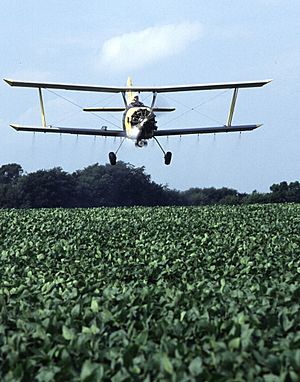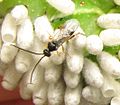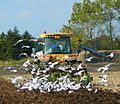Pest control facts for kids
Pest control is about managing animals and plants that humans see as harmful. These "pests" can hurt our health, our money, or the environment.
Pest control has been important for a very long time. As soon as people started farming, they needed to protect their crops. This was to stop other plants from growing too close. It also kept insects and animals from eating the food.
In our homes and cities, pests can be things like mice, birds, or insects. They share our living spaces. These pests might eat our food or damage our belongings. So, we try to control them.
Why Do We Need Pest Control?
Pests can cause many problems. They can spread diseases to people and animals. For example, mosquitoes can carry serious illnesses. Rats can also spread germs.
Pests can also damage our food. Insects might eat crops in the fields. They can also spoil food stored in homes or warehouses. This means less food for us to eat.
Some pests can harm our homes and buildings. Termites, for instance, can eat through wood. This can make a house unsafe. Other pests might just be annoying, like flies buzzing around.
How Do We Control Pests?
There are many different ways to control pests. The best method depends on the type of pest and where it is. People often use a mix of methods. This is called Integrated Pest Management (IPM).
Preventing Pests
One of the best ways to control pests is to stop them from coming in the first place. This is called prevention.
Keeping Pests Out
We can make it hard for pests to enter our homes. This means sealing cracks in walls. It also means fixing broken screens on windows and doors. Keeping food in sealed containers helps too. This stops pests from finding food easily.
Cleaning Up
Pests are often attracted to messy places. Keeping our homes and gardens clean helps a lot. Cleaning up food spills quickly is important. Taking out the trash regularly also helps. This removes food sources for pests.
Physical Pest Control
Physical methods involve directly removing or harming pests. These methods do not use chemicals.
Traps and Barriers
Traps are a common way to catch pests. Mouse traps are a good example. Sticky traps can catch insects. Barriers like fences can keep larger animals out of gardens. Nets can protect fruit trees from birds.
Removing Pests by Hand
Sometimes, you can just pick pests off plants. This works for larger insects like caterpillars. Weeds can also be pulled out by hand. This is a simple and effective method for small areas.
Changing the Environment
We can change the environment to make it less friendly for pests. For example, some insects need wet places to live. Draining standing water can reduce mosquito numbers. Ploughing fields can expose insect eggs to birds. This helps to reduce pest populations.
Biological Pest Control
This method uses natural enemies to control pests. It is a very eco-friendly way to manage pests.
Using Good Bugs
Some insects eat other insects. These are called beneficial insects. For example, ladybugs eat aphids, which are tiny plant pests. Farmers can release these good bugs into their fields. This helps to control the bad bugs naturally.
Other Animals
Animals like cats can help control rodents. Some birds eat a lot of insects. Encouraging these animals to live near farms can help with pest control. This creates a natural balance.
Chemical Pest Control
Chemicals called pesticides are used to kill pests. These can be very effective, but they must be used carefully.
Insecticides and Herbicides
Insecticides kill insects. Herbicides kill unwanted plants, or weeds. These chemicals can be sprayed on crops or in homes. They work by poisoning the pests.
Using Chemicals Safely
Pesticides can be harmful to people and other animals if not used correctly. It is important to follow instructions carefully. Only use the right amount. Also, make sure to wear protective gear. This helps keep everyone safe.
Fumigation
For very bad infestations, a whole building might be sealed off. Then, a special gas is released inside. This gas kills all the pests. This is called fumigation. It is often used for termites or bed bugs.
Images for kids
-
Biological pest control: parasitoid wasp (Cotesia congregata) adult with pupal cocoons on its host, a tobacco hornworm Manduca sexta (green background)
-
Cultivation by ploughing exposes insect pests to predators such as black-headed gulls.
-
Spraying pine logs with insecticide against Ips sexdentatus, a pine engraver beetle
-
A contemporary wood engraving of varmint hunters shooting passenger pigeons, a varmint species that was known to damage crops. Overhunting resulted in complete extinction of the species.
-
Dog control van, Rekong Peo, Himachal Pradesh, India
-
Rodent bait station, Chennai, India
-
Tent fumigation of a house in America
-
Brown rat infestation
-
The red flour beetle, Tribolium castaneum, attacks stored grain products worldwide.
-
Mosquito (Aedes aegypti) biting a human
-
Jet engine fan blades damaged by bird strike
See also
 In Spanish: Manejo de plagas para niños
In Spanish: Manejo de plagas para niños


















